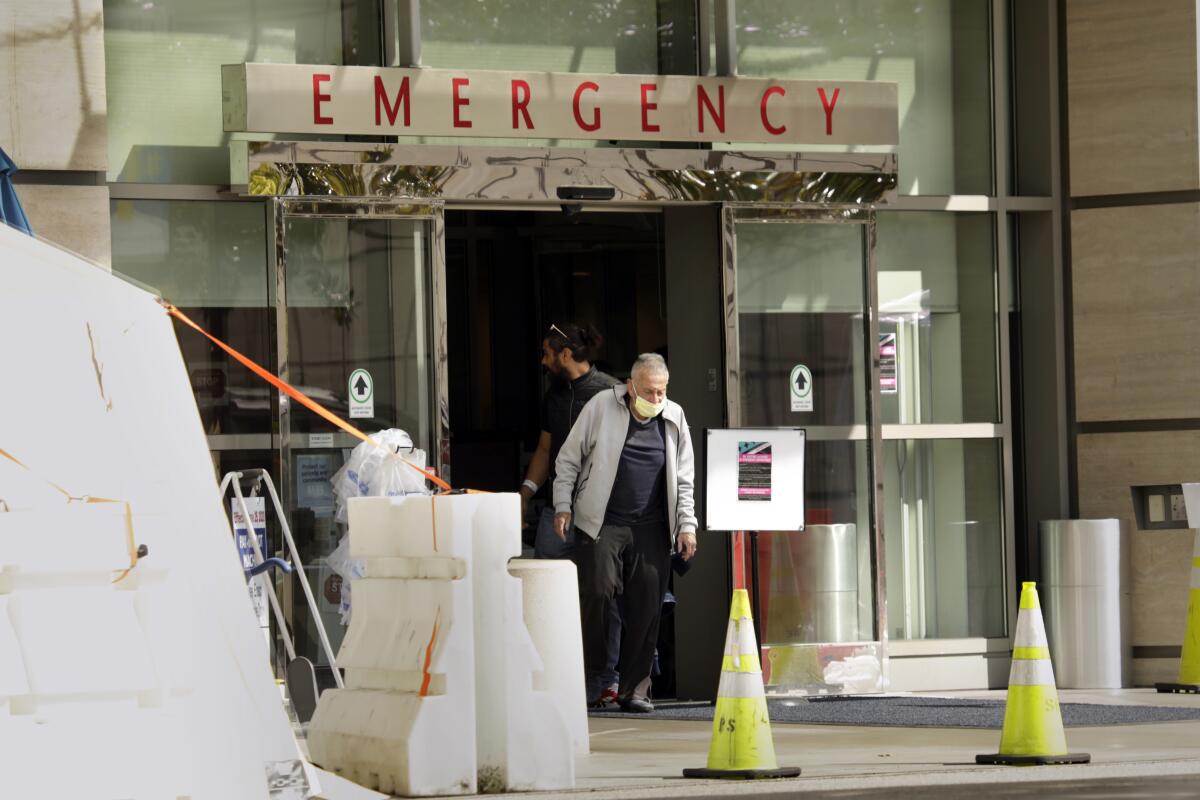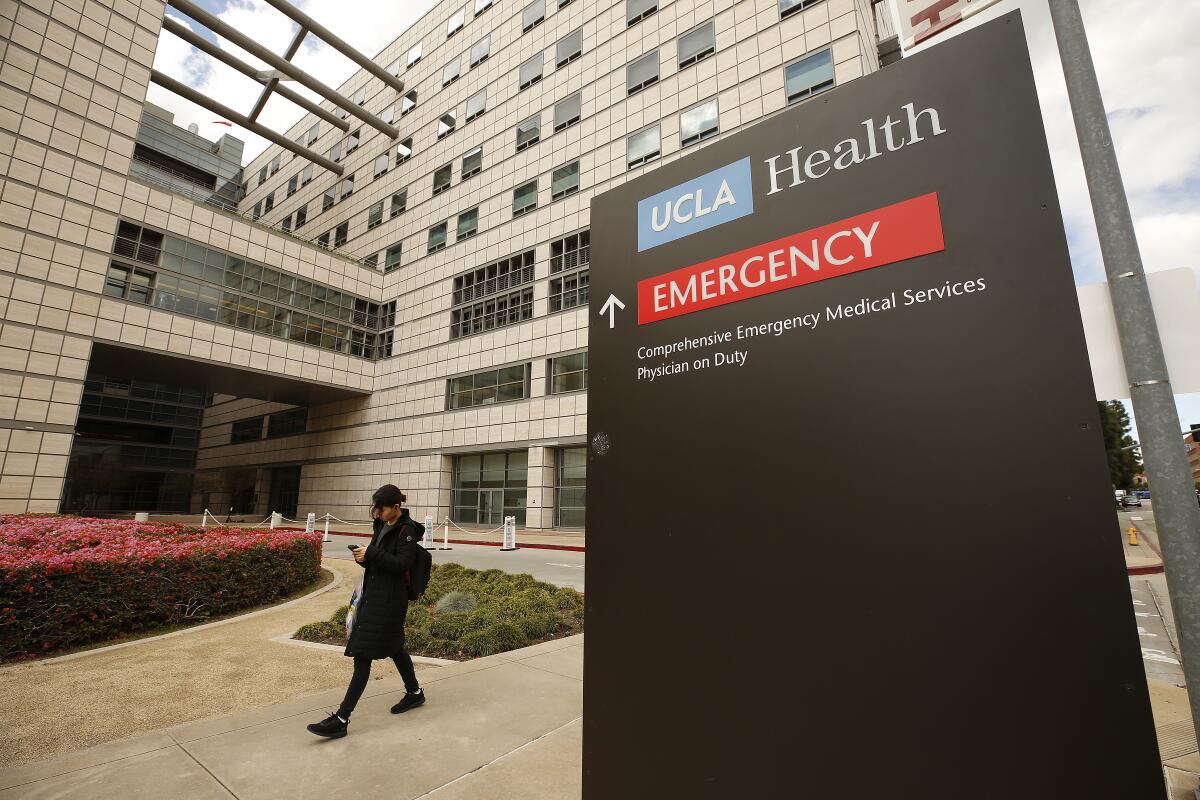Eerie calm before the storm gives ER doctors time to prepare, worry about what’s to come

- Share via
As the number of confirmed coronavirus cases continues its steep climb in California, many local emergency rooms remain eerily quiet, doctors say, giving them time to prepare but also time to agonize about what could be coming their way.
The L.A. County-USC Medical Center, the flagship hospital of the second-largest municipal health system in the country, can often feel like a war zone, said a physician who works there and spoke on the condition of anonymity. But in recent days, it has been strangely quiet.
Poor people who often use the emergency room as a combination urgent care and doctor’s office have stayed away, he said. “They have stepped up and the nonemergency [patients] that used to overwhelm our waiting room really have stayed home. The ER waiting room has never been this empty.”
Another physician, at Kaiser in Los Angeles, who spoke on the condition of anonymity, said the joke among the staff is that the only people showing up in their emergency room, “have coronavirus or are having a heart attack.”
An emergency room physician working at hospitals in San Bernardino County told The Times on Saturday morning, “patients are actually listening and the ER is just being used for emergencies.”
ER doctors aren’t the only emergency workers noticing the strange calm.
In L.A., fewer people are making 911 calls than at this same time last year, and fewer of the ambulances dispatched are taking patients to the hospital.
L.A. Fire Department Capt. Erik Scott said that in the past week, emergency transportation to local hospitals has been down by about 20% over the previous year.
“People are staying in their residences. They are being aggressive about hygiene and they are practicing social distancing, including [while] driving,” Scott said. “We’ve seen a decrease in traffic collisions.”
No doubt some people are refraining from using emergency services out of a sense of social responsibility. They don’t want to overburden the system in a time of crisis. But there’s another obvious reason for the slowdown: People are terrified of getting in an ambulance or entering an emergency room where they might contract COVID-19.
At Sutter Medical Center in Sacramento, doctors treat about 300 patients on a normal day. On Friday, they saw only 220, said Dr. Arthur Jey, an emergency medicine doctor who supervises the residency development program.
Self-isolation might prevent some injuries and other reasons for seeking help, but Jey said he was also concerned that patients with serious medical problems, such as strokes or heart attacks, might be waiting until the last possible moment to seek medical attention “because they are scared of the virus.”
“People who should be coming in are coming in later than they should,” he said.
Administrators at the Los Angeles County Department of Health Services confirmed that emergency room volume is down at County-USC Medical Center. There are a few reasons, said Dr. Hal F. Yee, the system’s chief medical officer. It’s the end of the usual flu season and there have been fewer traumatic injuries because people are following the advice to stay home.
“It is possible that people are avoiding the emergency room for the sake of social distancing, but we certainly hope that nobody is doing that if they have a medical emergency,” Yee added.
Fear of contracting the new, untreatable disease is also weighing, heavily, on the minds of emergency workers. Many say they are facing dangerous shortages of protective gear, especially the sturdy N95 face masks that are believed to be effective at blocking the virus.
Like her colleagues around the country, the San Bernardino ER doctor is deeply concerned about a critical shortage of the masks.
She described somewhat chaotic rationing of the equipment that is available and the lengths some of her co-workers are going to in an effort to conserve.
“They’re just wearing it the entire day and sterilizing it and guarding it with their life. I don’t use that term lightly, it’s real.”
At one of the hospitals where she works, administrators have discouraged staffers from walking around in the masks when they’re not dealing directly with a coronavirus case for fear of worrying other patients and employees who don’t have access to protective gear.
As an independent contractor, the doctor said administrators don’t have as much power over her. So she wears her mask — obtained on her own outside the hospital — whenever she thinks it’s appropriate.
But nurses are direct hospital employees so they’re not as free to buck the system.
“I’ve never been told by administrators not to wear a mask. If they told me that I would laugh in their face,” she said. But she’s worried about the nurses. “It does me no good to survive this if they all die, I can’t do their jobs!”
The anxiety of waiting and wondering how bad things are going to become is taking a serious toll and creeping up when she least expects it, especially at home with her kids.
“Today, my baby was begging me to pick him up and I had to stop myself and think twice,” she said.
“It makes me very sad and scared, and I don’t want to scare my kids...and it’s only going to get worse.”
At County-USC Medical Center, face shields are in high demand because they protect healthcare workers during the most high-risk procedures, such as intubation when the virus can be diffused into the air.
Staff members have been told the hospital has only a few hundred of them, said the doctor interviewed by The Times. If they wear one to treat a high-risk patient, they can dispose of the shield, but if the patient appears to be low risk, they have to wash the shield and reuse it.
There’s a sense of fear among the staffers, not just for their own health but for the well-being of family members and significant others.

“Everybody knows it’s going to get bad,” the doctor said, “but nobody knows exactly when.”
Emergency room nurse Angelica Jaime said that at the Ronald Reagan UCLA Medical Center, patients with legitimate medical needs are still coming, but those seeking treatment for “paper cuts” are a thing of the past.
“We used to have patients who come to the ER for refills of their prescription because their doctors couldn’t fit them in,” Jaime said.
Now, she said, the public seems to grasp what she and her colleagues have always known: “No one should be in the ER if they are not dying. Honestly.”
More to Read
Sign up for Essential California
The most important California stories and recommendations in your inbox every morning.
You may occasionally receive promotional content from the Los Angeles Times.












